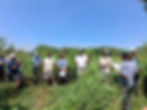Innovative Approaches to Riparian Restoration in Flood-Prone Vermont Landscapes
- FCNRCD
- Aug 22
- 4 min read
On Tuesday, July 15, 41 members from environmental organizations across Vermont joined the Franklin County Natural Resources Conservation District, U.S. Fish and Wildlife Partners for Fish and Wildlife Program, and the Vermont Agency of Agriculture (CREP program) for the second Innovative Riparian Buffer Event. This event featured two flood-impacted sites along the Lamoille River to discuss site preparation, flooding impacts, and adaptive species selection.
The group began at the Riverberry CREP site at Riverberry Farm in Fairfax, VT. This site presented difficult conditions for a successful riparian planting. Deer and vole browsing, dry, sandy soil, regular flooding, and competing vegetation made it difficult for trees to successfully survive the first years and grow and mature. Given the adverse conditions, this site presented a challenge to create a successful planting plan.

The Riverberry CREP site was first planted in 2014 at a density of 300 stems/acre, with a “plant and walk away” approach. The species selected were common species planted in riparian zones: Silver Maple, Cottonwood, Black Willow, Boxelder, Basswood. While all of these species are known to be resilient to flooding, they prefer a range of environmental conditions. Some, like the Black Willow, Silver Maple, and Boxelder, prefer wetter soils than the dry, sandy soil at Riverberry, and none of these species are particularly resistant to deer browsing. When surveyed in 2018, 90+ percent of stems were not present from the 2014 planting. A follow-up planting in 2019 focused on planting resilient species that could survive the dry soils, the rapid inundation of water from flooding, and be more resilient to deer brose.
For this planting, tree species were intentionally selected to deter deer from eating and killing the trees before they can mature. Species such as White Pine, Tamarack, Speckled Alder, and Paper Birch are generally avoided by deer, unlike more palatable species like Silver Maple and Red Maple that were likened to “deer candy”.
In the end, 100 Balsam Poplar, 300 Paper Birch, 300 White Pine, and 150 Chokecherry were selected as resilient species that could handle these pressures and planted. The trees were all bareroot trees, ideally 2-3' tall. This ideal size comes from a mix of variables – short enough to be less impacted by transplant stress, tall enough to have a decent chance of survival. Realistically, this size of trees planted is also impacted by how many trees can be bought with the available funding and which trees are available at the nursery. Follow-up tree maintenance of string trimming around the trees was completed in 2019, 2020, and 2021 by Vermont Youth Conservation Corps (VYCC), Intervale Conservation Nursery (ICN) -with Lake Champlain Basin Program (LCBP) funding, and USFWS staff.

To additionally combat vole browse, tree tubes were installed around the new plantings. Tree tubes are a cylindrical plastic barrier that protect the young trees from wildlife browsing during their first years of growth. Tree tubes do seem to be effective at combating animal browsing if used correctly, but can result in worse conditions for trees, especially in a floodplain, as mold, sediment, and debris can get stuck in the tubes.
Surveying the Riverberry site at the Innovative Riparian Buffer event, the White Pines and the Paper Birch had the best survival rate. Almost all other trees did not survive.
While this is not the most diverse outcome, the first goal of a riparian buffer planting is to grow trees to maturity in the buffer area. Once trees and vegetation are established, the forest will mature, and later successional species have a better chance to grow in.

The Boissoneault CREP Project site also presented a number of challenges. In addition to this site being prone to flooding, reed canary grass and vines dominate parts of the 20-acre site. Reed canary grass is a perennial grass that grows in wetlands, and once established, can easily outcompete native plants and young trees without outside maintenance.
This site was planted in the Spring of 2018 at 300 stems/acre. A glyphosate herbicide was applied around the planted stems to reduce competition from the reed canary grass. A second round of herbicide application was completed in June of 2018 to suppress the vines that dominated the drier areas of the site. Applying herbicide and suppressing the competing vegetation allowed the new stems to establish quickly and form a functional buffer.
Some of the more resilient species for wet soils were chosen for the areas dominated by reed canary grass (which was growing in the wettest areas), namely Black Willow, Shrub Willow, and Speckled Alder. A wide variety of trees were planted across the rest of the buffer, with Silver Maple, Basswood, Choke Cherry, and Paper Birch being planted in the highest quantities. These are all trees that have varying tolerances to prolonged wetland conditions but are all commonly found in floodplains that can handle rapid inundations of water from flooding.

The Franklin County NRCD truly enjoyed connecting with everyone to discuss riparian planting and share successes and setbacks from previous projects. We're excited to continue to protect Vermont’s waterways as a collaborative group of practitioners. From cleaner water to flood resilience, we all benefit from riparian buffers and more protected waterways. Thank you to all who attended this workshop and have expressed interest in riparian buffer projects!
To learn more about riparian plantings in difficult site conditions, explore this planting guide informed by the innovative planting procedures from this event.
To learn more about the CREP program in VT, explore these sites:
This project has been funded by the Vermont Agency of Natural Resources Department of Environmental Conservation and the Lake Champlain Basin Program.



